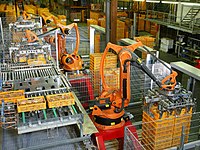
Photo from wikipedia
Abstract Three-dimensional printing of functional parts for different applications has increasingly attracted the interest of industries, owing to advantages such as seamless customization, a simplified supply chain, and on-demand production… Click to show full abstract
Abstract Three-dimensional printing of functional parts for different applications has increasingly attracted the interest of industries, owing to advantages such as seamless customization, a simplified supply chain, and on-demand production of prototypes. Hence, the mechanical properties of 3D prints subjected to different types of loads and exposed to factors specific to working and storage conditions must be studied. In this context, this study focuses on experimentally investigating the mechanical behavior of 3D-printed acrylonitrile butadiene styrene (ABS) specimens exposed to shelf life and multiple sterilizations, as these conditions are typical for medical instruments in a hospital environment. Tensile and flexural specimens were manufactured using fused deposition modeling (FDM) and were randomly divided into two groups. One group was used for evaluating the medium-term natural aging (shelf life) and as the control group for the sterilized specimens. Specimens in the second group underwent repeated sterilizations. Mechanical tests were performed on specimens from both groups, and comparisons of the results were made across groups and within individual groups. The fracture patterns of sterilized and non-sterilized specimens were characterized using scanning electron microscopy (SEM) and industrial computer tomography (CT) was performed to understand the experimental findings. The results show that natural aging and repeated sterilizations do not influence mechanical performance in terms of stiffness and strength in tension and flexion. However, other properties, such as creep, wear, and fatigue should also be considered with regard to sterilization, depending on the instrument functionality.
Journal Title: Mechanics of Materials
Year Published: 2020
Link to full text (if available)
Share on Social Media: Sign Up to like & get
recommendations!